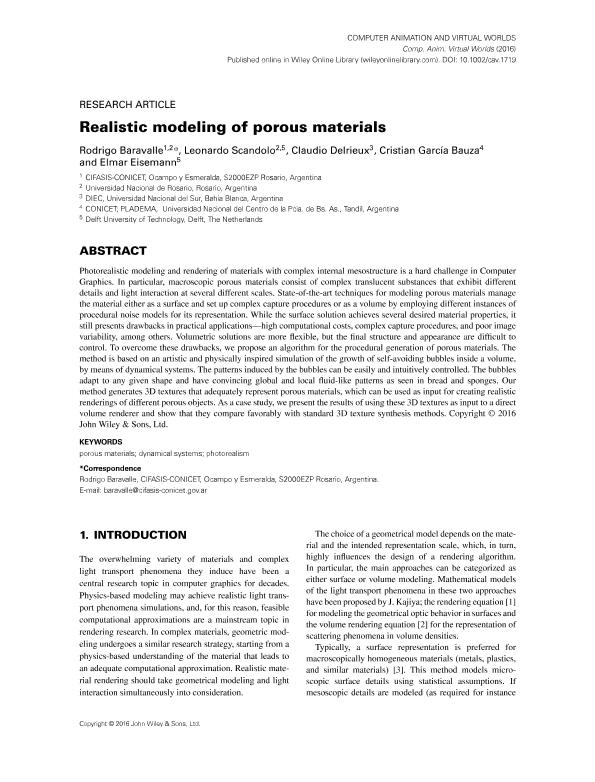Mostrar el registro sencillo del ítem
dc.contributor.author
Baravalle, Rodrigo Guillermo

dc.contributor.author
Scandolo, Leonardo
dc.contributor.author
Delrieux, Claudio Augusto

dc.contributor.author
Garcia Bauza, Cristian Dario

dc.contributor.author
Eisemann, Elmar
dc.date.available
2018-05-30T14:52:33Z
dc.date.issued
2016-05-03
dc.identifier.citation
Baravalle, Rodrigo Guillermo; Scandolo, Leonardo; Delrieux, Claudio Augusto; Garcia Bauza, Cristian Dario; Eisemann, Elmar; Realistic modeling of porous materials; John Wiley & Sons Ltd; Computer Animation and Virtual Worlds; 28; 2; 3-5-2016; 1-13
dc.identifier.issn
1546-4261
dc.identifier.uri
http://hdl.handle.net/11336/46598
dc.description.abstract
Photorealistic modeling and rendering of materials with complex internal mesostructure is a hard challenge in Computer Graphics. In particular, macroscopic porous materials consist of complex translucent substances that exhibit different details and light interaction at several different scales. State‐of‐the‐art techniques for modeling porous materials manage the material either as a surface and set up complex capture procedures or as a volume by employing different instances of procedural noise models for its representation. While the surface solution achieves several desired material properties, it still presents drawbacks in practical applications—high computational costs, complex capture procedures, and poor image variability, among others. Volumetric solutions are more flexible, but the final structure and appearance are difficult to control. To overcome these drawbacks, we propose an algorithm for the procedural generation of porous materials. The method is based on an artistic and physically inspired simulation of the growth of self‐avoiding bubbles inside a volume, by means of dynamical systems. The patterns induced by the bubbles can be easily and intuitively controlled. The bubbles adapt to any given shape and have convincing global and local fluid‐like patterns as seen in bread and sponges. Our method generates 3D textures that adequately represent porous materials, which can be used as input for creating realistic renderings of different porous objects. As a case study, we present the results of using these 3D textures as input to a direct volume renderer and show that they compare favorably with standard 3D texture synthesis methods.
dc.format
application/pdf
dc.language.iso
eng
dc.publisher
John Wiley & Sons Ltd

dc.rights
info:eu-repo/semantics/openAccess
dc.rights.uri
https://creativecommons.org/licenses/by-nc-sa/2.5/ar/
dc.subject
DYNAMICAL SYSTEMS
dc.subject
PHOTOREALISM
dc.subject
POROUS MATERIALS
dc.subject.classification
Ingeniería de Sistemas y Comunicaciones

dc.subject.classification
Ingeniería Eléctrica, Ingeniería Electrónica e Ingeniería de la Información

dc.subject.classification
INGENIERÍAS Y TECNOLOGÍAS

dc.title
Realistic modeling of porous materials
dc.type
info:eu-repo/semantics/article
dc.type
info:ar-repo/semantics/artículo
dc.type
info:eu-repo/semantics/publishedVersion
dc.date.updated
2018-05-04T21:06:30Z
dc.journal.volume
28
dc.journal.number
2
dc.journal.pagination
1-13
dc.journal.pais
Reino Unido

dc.journal.ciudad
Londres
dc.description.fil
Fil: Baravalle, Rodrigo Guillermo. Consejo Nacional de Investigaciones Científicas y Técnicas. Centro Científico Tecnológico Conicet - Rosario. Centro Internacional Franco Argentino de Ciencias de la Información y de Sistemas. Universidad Nacional de Rosario. Centro Internacional Franco Argentino de Ciencias de la Información y de Sistemas; Argentina
dc.description.fil
Fil: Scandolo, Leonardo. Universidad Nacional de Rosario; Argentina. Delft University of Technology; Países Bajos
dc.description.fil
Fil: Delrieux, Claudio Augusto. Consejo Nacional de Investigaciones Científicas y Técnicas. Centro Científico Tecnológico Conicet - Bahía Blanca; Argentina. Universidad Nacional del Sur. Departamento de Ingeniería Eléctrica y de Computadoras; Argentina
dc.description.fil
Fil: Garcia Bauza, Cristian Dario. Consejo Nacional de Investigaciones Científicas y Técnicas; Argentina. Universidad Nacional del Centro de la Provincia de Buenos Aires. Facultad de Ciencias Exactas. Grupo de Plasmas Densos Magnetizados. Provincia de Buenos Aires. Gobernación. Comision de Investigaciones Científicas. Grupo de Plasmas Densos Magnetizados; Argentina
dc.description.fil
Fil: Eisemann, Elmar. Delft University of Technology; Países Bajos
dc.journal.title
Computer Animation and Virtual Worlds

dc.relation.alternativeid
info:eu-repo/semantics/altIdentifier/url/http://onlinelibrary.wiley.com/doi/10.1002/cav.1719/abstract
dc.relation.alternativeid
info:eu-repo/semantics/altIdentifier/doi/http://dx.doi.org/10.1002/cav.1719
Archivos asociados
